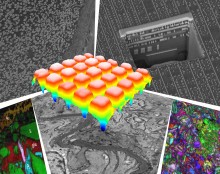Projects
Projects at a Glance
OPTOMETAMAG - Optical-control of thermally driven magnetic phase transitions in metamaterials
The project aims at developing hybrid systems combining the ultralow energy, speed, and control of plasmonic opto-heating with the unique property of nanoscale graded magnetic metamaterials to display magnetic phase transitions across precisely engineered critical temperatures.
LSD - Low-dimensional Spin Devices
This project explored materials and architectures with low dimensionality and symmetry to develop spintronic devices. We created structures based on van der Waals materials or quiral materias in order to study the effect of symmetry breaking on the materials’ spin properties.
HiMat - Hybrid layered materials for next generation electronics
HiMat focuses on the development of hybrid layered materials (HLMs) with tailored physical properties and their integration in lab-scale devices for opto- and spin- electronics or quantum computing. By taking advantage from the chemical flexibility of organic molecules, HiMat explores tailored HLMs obtained through a top-down approach as intercalated compounds and through a bottom-up approach as organic-inorganic metal-halide perovskites.
NANOSPEC - Advanced near-field optical nanospectroscopy and novel applications in material sciences and nanophotonics
The objectives of the project include establishing correlative nano-FTIR, TERS, and TEPL spectroscopy, studying industrially relevant polymers, exploring organic conductors' conductivity, and investigating phonon polaritons in 2D materials. The project targets developing advanced near-field spectroscopy instrumentation and achieving vibrational strong coupling in nanoresonators and molecular vibrations.
CARDIOPRINT - Advanced multifunction 3D biofabrication for the generation of computationally modelled human-scale therapeutic cardiac tissues
CARDIOPRINT is born with the ambition of shaping a quantum leap in the fields of Additive Manufacturing and Biofabrication of therapeutic human cardiac tissues, at both the technological and applicative levels. The overall concept of this enterprising project is to develop a new multifunctional additive manufacturing technology able to provide the sufficient accuracy for the manufacturing of human tissues at an organ scale for the first time.
MULTISPIN - Molecular engineering of layered magnetic materials: towards multifunctional spintronic devices
MULTISPIN proposes to take advantage of the chemical programmability of (macro)molecules to engineer the physical and chemical properties of LMMs, enabling the precise tuning of their magnetic properties and the demonstration of opto-spintronic devices with new functionalities.
SNOMCELL - Near-field microscopy for label-free ultrastructural pathology
This project aims at establishing s-SNOM as a platform technology for label-free ultrastructural pathology. s-SNOM is an emerging technique -- co-developed at nanoGUNE -- that beats the diffraction limit and allows for obtaining infrared images with nanoscale spatial resolution. Applied to ultrathin cell sections, s-SNOM will allow for an unprecedented view on the chemical composition of the interior of a cell that cannot be easily calculated nor measured. Thus, s-SNOM will provide a reference data set that will help to validate already existing medical application of infrared microscopy and may even lead to the discovery of new nano-IR biomarkers.
FunMolSys - On-surface Synthesis of Functional Molecular Systems
This is a collaborative research project funded by the Spanish Research Agency (AEI) for synthetizing functional complex carbon-based molecular nanostructures with atomic precision and testing their potential operability as functional units in various technological applications, such as spintronics, topological engineering, (opto)electronics, thermoelectricity, and chemical and molecular sensing and filtering. FunMolSys combines the work of six Spanish research groups in Galicia (CiQUS at the University of Santiago de Compostela), Euskadi (the CFM, Centro de Física de Materiales - CSIC-UPV, and CIC nanoGUNE), Aragón (the ICMA, Instituto de Ciencia de Materiales de Aragón – CSIC-UZ), and Catalunya (the ICN2, Instituto Catalán de Nanociencia y Nanotecnología). In the last years, FunMolSys has produced novel strategies for synthesis of customized graphene platforms over metallic surfaces and identification of their new electronic and magnetic properties with a combination of multiple experimental methods, theoretical tools, and multidisciplinary expertise. Within FulMolSys, the research groups of Theory and nanoimaging, led by Profs. Artacho and Pascual, respectively, contributed with a sub-project entitled “Magnetism and topological states of on-surface engineered molecular nanosystems”
MicroMech - Nanomechanics of Microbial Infection:Towards Mechanopharmacology
Microbes use surface proteins to infect hosts, with bacterial adhesins, like long filaments, crucial for attachment, resisting mechanical forces from pico to nanoNewtons. This resistance is vital for anchoring in shear-rich environments like urinary tract infections. Understanding the link between adhesin mechanical resistance, attachment ability, and pathogenicity remains incomplete. The proposal aims to study Staphylococcus aureus mechanics in active endocarditis, exploring adhesin proteins Clumping factor A (ClfA) and Fibronectin-binding protein A (FnBPA) connections to infection. Techniques span atomic force spectroscopy, magnetic tweezers, and clinical S aureus strains, seeking to correlate pathogenicity with adhesin mechanics and discover molecules to prevent infections, contributing to Mechanopharmacology.
By funding program
Contact

Yurdana Castelruiz
Projects Manager
+ 34 943574022
y.castelruiz[at]nanogune.eu


